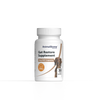Fleas are a common nuisance for pet owners and anyone who enjoys spending time outdoors. These tiny parasites can be difficult to manage, especially during warmer months when their populations thrive in soil, grass, and shaded areas. If you're looking for a more natural approach to reducing flea activity around your home, beneficial nematodes for fleas might be worth exploring.
In this article, we’ll explain what beneficial nematodes are, how they work, and why they’re gaining attention as a safe and eco-conscious option for managing flea populations outdoors.
What Are Beneficial Nematodes?
Beneficial nematodes are microscopic, soil-dwelling roundworms that naturally occur in many outdoor environments. Unlike harmful parasites, these nematodes don’t affect people, pets, or plants. Instead, they target specific insects and pests that live in the soil, including flea larvae.
There are several species of nematodes, but the ones used to manage flea populations typically belong to the Steinernema and Heterorhabditis genera. These nematodes locate their hosts by sensing heat, carbon dioxide, and movement in the soil.
How Do Beneficial Nematodes Work?
When applied to moist soil areas where pets rest or play, these nematodes actively seek out flea larvae and pupae. They enter these pests through natural openings and release symbiotic bacteria that kill the host within 24–48 hours
Once released into the soil, beneficial nematodes begin to search for flea larvae and pupae. When they find a host, they enter through natural body openings and release symbiotic bacteria. This process ultimately causes the host to stop developing and kills it within 24–48 hours. Afterward, the nematodes reproduce inside the flea’s body and then move on to find another host.
Because beneficial nematodes for fleas live underground, they are most effective during the early stages of the flea life cycle, before the fleas reach adulthood and begin to reproduce.
Are Beneficial Nematodes Safe for Dogs and Cats?
Yes, beneficial nematodes are considered safe for both dogs and cats. These microscopic organisms are naturally found in soil and target specific insect pests, not mammals. They do not bite, sting, or produce any residues that would harm your pets. Once applied, they remain in the soil, where they continue their role in reducing insect populations such as flea larvae.
Because beneficial nematodes only live in moist soil environments, they won’t transfer to your pet’s skin or coat. In fact, many pet owners use them confidently in outdoor spaces like dog runs, yards, or garden areas where pets like to rest or play. Just make sure to follow application instructions carefully, particularly when it comes to dilution and storage.
If your dogs or cats enjoy digging in the yard, there’s no cause for concern. The nematodes will simply continue their microscopic work underground without posing a threat to curious paws or noses.
Why Use Beneficial Nematodes in the Yard?
Many flea control methods focus on adult fleas that are already active on pets or in the home. However, up to 95% of a flea population consists of eggs, larvae, and pupae that live in soil and shaded areas outdoors. Targeting these earlier stages where they live can help support a more balanced yard environment.
Here are several reasons pet owners and gardeners are turning to beneficial nematodes for fleas:
-
Natural origin – Nematodes occur naturally and don’t introduce synthetic chemicals into your yard.
-
Pet-safe and people-safe – These microscopic organisms target insects without affecting dogs, cats, or children playing outside.
-
Biodegradable – Once their food source is depleted, nematode populations decline naturally.
-
Soil health – Some nematodes may also help improve soil aeration and nutrient cycling.
Where to Apply Beneficial Nematodes
Fleas tend to thrive in warm, moist, shaded environments—particularly areas where pets spend time outdoors. For the best results, apply nematodes to:
-
Shaded grass areas
-
Under decks or porches
-
Along fence lines
-
Outdoor kennels or dog runs
-
Garden beds and mulch piles
Avoid applying them in direct sunlight, as UV rays can reduce nematode activity. Early morning or late afternoon is usually the best time for application.
How to Use Beneficial Nematodes for Fleas
Beneficial nematodes are usually sold in concentrated forms (powder or sponge) that require dilution with water. Follow the specific instructions from the product manufacturer, but here’s a general guide:
-
Choose the right nematode species – Look for varieties labeled for use against fleas, such as Steinernema carpocapsae or Heterorhabditis bacteriophora.
-
Mix with water – Dilute the nematodes in a watering can, sprayer, or hose-end applicator.
-
Water the area – Lightly moisten the soil before applying to help nematodes move through the ground.
-
Apply evenly – Spray across high-traffic pet areas and flea-prone spots.
-
Keep the soil moist – Water the treated areas daily for about a week to support nematode activity.
When to Apply Beneficial Nematodes
Timing is key. Apply nematodes during the early spring or late summer, when flea populations are just beginning to rise. Since nematodes are sensitive to extreme temperatures and UV light, mild weather and damp soil help ensure better results.
You can also reapply nematodes throughout the year if needed, especially after heavy rainfall or extended dry periods.
Do Nematodes Eliminate Fleas Completely?
While beneficial nematodes can reduce the number of immature fleas in your yard, they are not a standalone solution. Fleas have a complex life cycle and can come from neighboring yards, wildlife, or even indoor environments.
Using beneficial nematodes for fleas works best as part of a broader approach that includes:
-
Regularly washing pet bedding
-
Grooming pets with a flea comb
-
Vacuuming carpets and upholstery
-
Maintaining a tidy yard
Think of nematodes as one piece of the puzzle that supports a less favorable environment for fleas to thrive in.
Are There Any Risks?
Beneficial nematodes are generally regarded as safe when used as directed. They don’t bite, sting, or transmit diseases. However, improper storage (such as leaving them in heat or direct sunlight) can kill them before you even apply them.
Always check the expiration date, store them in a cool place, and use them within the recommended time frame. Nematodes are living organisms and need to be handled with care.
What to Expect After Application
You won’t see nematodes working because they’re invisible to the naked eye. However, over the following 7–14 days, you may notice fewer signs of flea activity outdoors. It’s important to be consistent and patient. Nematodes don’t offer instant results, but their ongoing activity in the soil helps manage flea populations over time.
If you’re applying them for the first time, consider
Final Thoughts
Using beneficial nematodes for fleas is a gentle and thoughtful way to support a healthier yard environment. By targeting flea life stages in the soil, you create a space that’s less inviting to pests—without relying on harsh ingredients. Whether you’re a pet parent or a home gardener, these microscopic allies offer an earth-friendly option to include in your seasonal care routine.
✨ Explore Dr. Ruth’s Flea & Tick Protocol – Our carefully selected natural products are pet-safe and designed to support your dog or cat with a holistic approach. View the Protocol →
📚 Want to learn more? Read our full blog on other natural and holistic ways to support dogs against flea, tick, and heartworm exposure. Read the Blog →
🤝 Need personalized guidance? Book a session with a certified Holistic Pet Health Coach to create a safe, effective plan tailored to your pet’s environment and lifestyle. Book a Consultation →
















